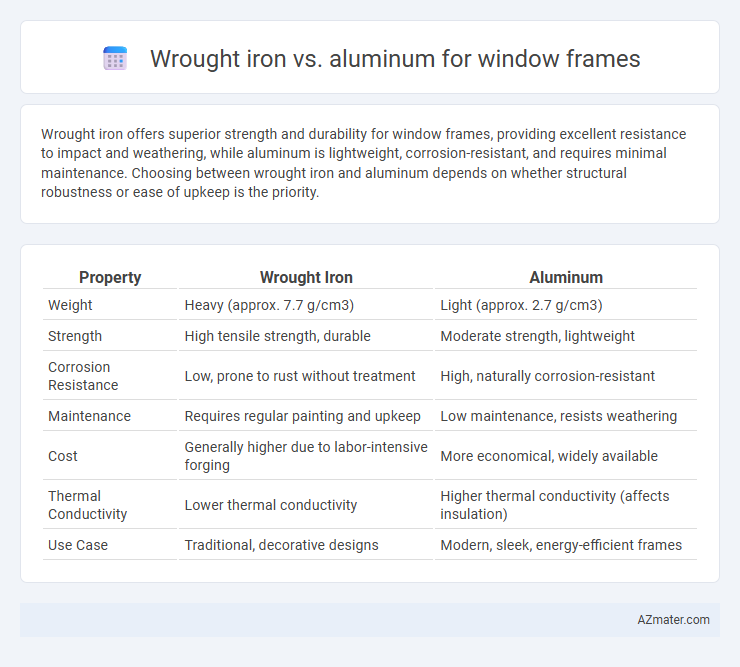Wrought iron offers superior strength and durability for window frames, providing excellent resistance to impact and weathering, while aluminum is lightweight, corrosion-resistant, and requires minimal maintenance. Choosing between wrought iron and aluminum depends on whether structural robustness or ease of upkeep is the priority.
Table of Comparison
| Property | Wrought Iron | Aluminum |
|---|---|---|
| Weight | Heavy (approx. 7.7 g/cm3) | Light (approx. 2.7 g/cm3) |
| Strength | High tensile strength, durable | Moderate strength, lightweight |
| Corrosion Resistance | Low, prone to rust without treatment | High, naturally corrosion-resistant |
| Maintenance | Requires regular painting and upkeep | Low maintenance, resists weathering |
| Cost | Generally higher due to labor-intensive forging | More economical, widely available |
| Thermal Conductivity | Lower thermal conductivity | Higher thermal conductivity (affects insulation) |
| Use Case | Traditional, decorative designs | Modern, sleek, energy-efficient frames |
Introduction to Window Frame Materials
Wrought iron window frames offer exceptional strength, durability, and a classic aesthetic, making them ideal for historic or decorative applications. Aluminum window frames provide lightweight, corrosion-resistant, and low-maintenance properties, often favored for modern architectural designs and energy-efficient installations. Both materials differ significantly in thermal conductivity, cost, and design flexibility, influencing their selection based on project requirements.
Overview of Wrought Iron Window Frames
Wrought iron window frames are renowned for their exceptional strength, durability, and classic aesthetic appeal, often featuring intricate designs that enhance architectural elegance. These frames provide superior resistance to weather elements and security due to their robust metal composition and ability to withstand impact. Despite being heavier and requiring regular maintenance to prevent rust, wrought iron frames offer timeless beauty and structural integrity unmatched by lighter materials like aluminum.
Overview of Aluminum Window Frames
Aluminum window frames offer outstanding durability and resistance to corrosion, making them ideal for diverse climates. Their lightweight nature allows for larger glass panes and slimmer profiles, enhancing natural light and modern aesthetics. Energy-efficient thermal breaks in aluminum frames improve insulation, reducing heat transfer and lowering energy costs.
Durability Comparison: Wrought Iron vs Aluminum
Wrought iron window frames exhibit exceptional durability due to their high tensile strength and resistance to impact, making them ideal for long-lasting structural integrity and security. Aluminum frames offer excellent corrosion resistance and require minimal maintenance, thriving in varying weather conditions without rusting or warping. While wrought iron can be prone to rust if not properly treated, aluminum's lightweight nature combined with its resilience provides a durable option for environments exposed to moisture and fluctuating temperatures.
Aesthetic Differences and Design Options
Wrought iron window frames offer a classic, ornate aesthetic characterized by intricate detailing and a robust, timeless appeal suited for traditional or vintage architecture. Aluminum frames provide a sleek, modern look with clean lines, minimalistic profiles, and versatile finishes that complement contemporary design styles. Both materials support various customization options, but wrought iron emphasizes decorative patterns while aluminum excels in slim frames and color variety for a streamlined appearance.
Maintenance Requirements for Each Material
Wrought iron window frames require regular maintenance including sanding, priming, and repainting to prevent rust and corrosion, especially in humid or coastal environments. Aluminum frames demand minimal upkeep, usually limited to occasional cleaning with mild soap and water to maintain their resistance to rust and weathering. Choosing aluminum reduces long-term maintenance costs due to its corrosion-resistant properties and lightweight durability compared to the more maintenance-intensive wrought iron.
Energy Efficiency and Insulation Performance
Wrought iron window frames offer strong durability but have poor thermal insulation properties, leading to higher energy loss compared to aluminum frames with thermal breaks. Aluminum window frames, especially those with thermal barriers, provide superior energy efficiency by reducing heat transfer and improving insulation performance. Choosing aluminum over wrought iron can significantly enhance a building's overall energy conservation and interior temperature regulation.
Cost Analysis: Initial and Long-Term Investment
Wrought iron window frames have a higher initial cost due to expensive materials and fabrication but offer exceptional durability that can reduce long-term maintenance expenses. Aluminum frames are more affordable upfront, lightweight, and resistant to corrosion, minimizing ongoing costs related to repairs and repainting. Considering the total cost of ownership, wrought iron suits projects prioritizing longevity and aesthetic value, while aluminum provides a budget-friendly option with low maintenance needs.
Security and Safety Considerations
Wrought iron window frames offer superior security due to their high tensile strength and resistance to impact, making unauthorized entry significantly more difficult. Aluminum frames, while lightweight and corrosion-resistant, are generally less robust and easier to breach under force. For enhanced safety, wrought iron's durability provides better protection against break-ins and vandalism, whereas aluminum may require additional reinforcements to achieve comparable security levels.
Which Window Frame Material is Best for Your Home?
Wrought iron window frames offer exceptional strength, durability, and a classic aesthetic, making them ideal for secure, traditional-style homes, while aluminum frames provide lightweight, corrosion-resistant, and low-maintenance options suited for modern designs and coastal environments. Choosing the best material depends on factors like climate, home style, budget, and maintenance preferences. Aluminum is typically better for energy efficiency and contemporary applications, whereas wrought iron excels in durability and ornate customization.

Infographic: Wrought iron vs Aluminum for Window frame
 azmater.com
azmater.com